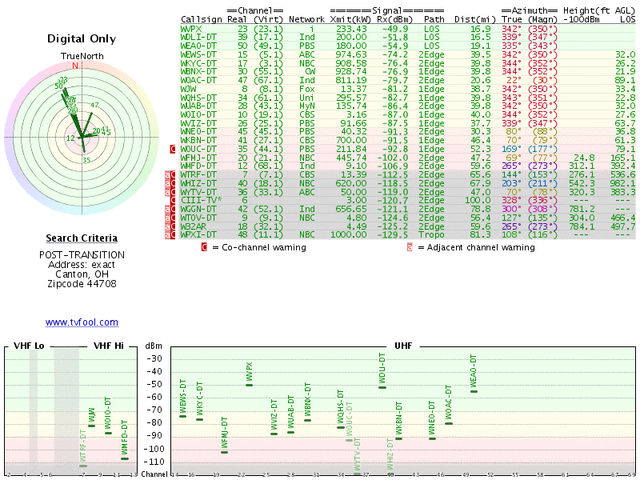Hi,
I was hoping for an antenna recommendation to service my elderly parents home.
I picked up a couple Zenith DT900 digital converter boxes and set top rabbit ears only pick up 2 stations and none of the big 4 networks. If possible I would prefer to do an attic mount in the crawlspace of their single story ranch as they are opposed to an outside antenna. There are 3 different televisions that need a hookup to the antenna.
I'm reasonably geeky in that I've built my own Mythtv system and made a DB2 clone for my own use but I've never done an install with multiple ~100ft cable runs to separate televisions so I'm unclear on amp/preamp choices and it seems like I would also need something like a distribution amp to service 3 tvs.
I've attached tvfool data for the location. My intention is to take my homemade DB2 up into their crawlspace as a test run to see if I can get anything at all. Initially it seems like a CM4228 might be a good candidate as most of the stations are in the same general direction and there are 2 must have(Fox8/CBS10) VHF Hi stations.
I'd appreciate any experienced advice.
I was hoping for an antenna recommendation to service my elderly parents home.
I picked up a couple Zenith DT900 digital converter boxes and set top rabbit ears only pick up 2 stations and none of the big 4 networks. If possible I would prefer to do an attic mount in the crawlspace of their single story ranch as they are opposed to an outside antenna. There are 3 different televisions that need a hookup to the antenna.
I'm reasonably geeky in that I've built my own Mythtv system and made a DB2 clone for my own use but I've never done an install with multiple ~100ft cable runs to separate televisions so I'm unclear on amp/preamp choices and it seems like I would also need something like a distribution amp to service 3 tvs.
I've attached tvfool data for the location. My intention is to take my homemade DB2 up into their crawlspace as a test run to see if I can get anything at all. Initially it seems like a CM4228 might be a good candidate as most of the stations are in the same general direction and there are 2 must have(Fox8/CBS10) VHF Hi stations.
I'd appreciate any experienced advice.
Attachments
Last edited:


